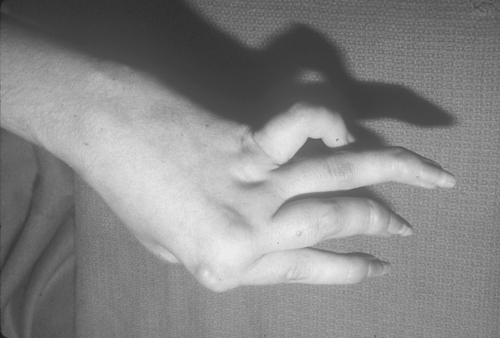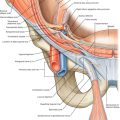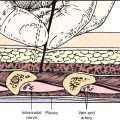CHAPTER 34
Hand Rheumatoid Arthritis
Definition
Rheumatoid arthritis is a systemic inflammatory disorder of unknown etiology. It is a progressive condition that results in deformity and dysfunction when synovial inflammation erodes cartilage, bone, and soft tissues. However, the widespread early use of methotrexate has transformed rheumatoid arthritis into a much less devastating disease [1]. The availability of targeted biologic therapies, such as the tumor necrosis factor (TNF) antagonists, has further improved the outcome of rheumatoid arthritis [2]. Surgery has become much less common and more straightforward in patients with rheumatoid arthritis. For a detailed discussion of rheumatoid arthritis, see Chapter 151.
Symptoms
Presenting symptoms in the hand include joint pain in the fingers as well as stiffness and swelling, typically involving the proximal interphalangeal and metacarpophalangeal joints but—in contrast to osteoarthritis—sparing the distal interphalangeal joints. Stiffness usually is most pronounced in the morning. If it is left untreated, rheumatoid arthritis may result in progressive deformity and disability.
Physical Examination
The evaluation of a rheumatoid arthritic hand should include the following: joint pain and inflammation; joint stability; limitations in active and passive range of motion for grip and pinch strength deficits; limitations in hand dexterity; and degree of disability with respect to self-care, vocational activities, and recreational activities.
Early in the course of disease, involved joints are usually stiff, painful, and swollen as synovitis predominates. In some patients, the first sign of rheumatoid arthritis may be extensor tenosynovitis on the dorsum of the hand and wrist (although this can also be an idiopathic condition). Chronic synovitis may destroy capsuloligamentous and tendinous structures, creating laxity and deformity. In rheumatoid arthritis, in contrast to the arthritis of systemic lupus erythematosus, this soft tissue damage is usually accompanied by destruction of bone with periarticular erosions evident on radiographs.
Typical hand deformities associated with advanced rheumatoid arthritis include boutonnière deformity (flexion deformity of the proximal interphalangeal joint and extension deformity of the distal interphalangeal joint) and swan-neck deformity (hyperextension of the proximal interphalangeal joint with flexion of the distal interphalangeal joint). It is not uncommon to see varying patterns on the fingers of one hand (Fig. 34.1).

Inability to extend the index through small fingers may be due to the following: deformity and subluxation or dislocation of the index through small finger metacarpophalangeal joints; ulnar translocation of the extensor tendons due to laxity and destruction of the radial sagittal bands; extensor tendon ruptures due to a combination of dorsal tenosynovitis and distal radioulnar joint deformity or abrasions; or posterior interosseous nerve compression by elbow synovitis. Ulnar drift of the fingers usually accompanies each of these deformities.
Rupture of the extensor tendons usually proceeds in a sequence from ulnar to radial, referred to as the Vaughn-Jackson syndrome [3]. Mannerfelt syndrome is the equivalent on the volar side, progressing from the thumb to the index and long fingers, producing tendon ruptures as a result of synovitis and scaphotrapezial trapezoid irregularity [4].
Synovitis in the wrist results in volar and ulnarward subluxation and supination of the hand in relation to the forearm. This wrist deformity can exacerbate the Vaughn-Jackson syndrome and ulnar drift.
Extensive synovitis or tenosynovitis can cause nerve compression, but, except for carpal tunnel syndrome, this is uncommon now that synovitis is controlled by effective medications.
Functional Limitations
Surgery is considered when correction of a deformity will improve function. Rheumatoid deformities typically progress slowly, and patients often adapt well. In some cases, realignment or stabilization of one joint or finger will actually decrease function because it will interfere with an adaptive mechanism. For this reason, surgery for rheumatoid deformity must carefully match the functional desires and goals of the patient with the risks and benefits of operative intervention. Many severe deformities are left untreated when patients have adapted well.
Diagnostic Studies
The diagnosis of rheumatoid arthritis is based predominantly on its clinical presentation. Laboratory testing is used to monitor disease activity and toxicity of drug therapy. Acute phase reactants, such as C-reactive protein and erythrocyte sedimentation rate, may be elevated in the setting of active joint inflammation. Most patients with rheumatoid arthritis have circulating rheumatoid factor or anti-citrullinated protein antibodies. The presence of one of these serologic markers suggests a more aggressive and destructive disease course.
Diffuse periarticular osteopenia is the earliest radiographic sign of rheumatoid arthritis. Joint space narrowing and periarticular erosions may be observed in more than half of patients with rheumatoid arthritis during the first 2 years of disease [5]. If left untreated, joints involved by rheumatoid arthritis may be destroyed by chronic synovitis.
Diagnostic ultrasonography is often used to detect early erosions and joint swelling in patients with rheumatoid arthritis [6]. Magnetic resonance imaging of the hand may reveal synovitis and erosions early in the course of rheumatoid arthritis. However, radiographs remain the reference standard for diagnostic imaging of rheumatoid arthritis.
Treatment
Initial
Nonsteroidal anti-inflammatory drugs decrease pain and inflammation by inhibiting prostaglandin synthesis; they do not inhibit synovial proliferation and thus do not slow the progression of bone erosion and joint destruction. Low-dose corticosteroids also reduce symptoms of joint inflammation; but unlike nonsteroidal anti-inflammatory drugs, low-dose corticosteroids retard the progression of joint destruction. However, the widespread use of corticosteroids is limited by their many deleterious side effects, including osteoporosis, osteonecrosis of bone, cataracts, cushingoid features, and hyperglycemia.
Since the mid-1980s, the widespread and early use of low-dose weekly methotrexate has transformed rheumatoid arthritis into a much less destructive disease than it had been previously. Leflunomide also may be used to suppress synovial proliferation and joint destruction [7]. Other disease-modifying antirheumatic drugs (DMARDs) that have been used to treat rheumatoid arthritis include antimalarial drugs such as hydroxychloroquine, sulfasalazine, intramuscular and oral gold, D-penicillamine, immunosuppressive agents (azathioprine and cyclophosphamide), and cyclosporine.
Since the late 1990s, targeted biologic therapies have been used to treat rheumatoid arthritis and other inflammatory diseases. TNF antagonists, such as adalimumab, certolizumab pegol, etanercept, golimumab, and infliximab result in the rapid and marked improvement of signs and symptoms of joint inflammation and dramatically slow the rate of joint destruction [8–12]. Abatacept (an inhibitor of T-cell costimulation), tocilizumab (a monoclonal anti-IL-6 receptor antibody), and rituximab (a monoclonal anti–B-cell antibody) have also been approved by the U.S. Food and Drug Administration to treat patients with rheumatoid arthritis; tocilizumab and rituximab are each approved to treat patients who have had an inadequate response to one or more TNF antagonists, whereas abatacept is approved to treat patients who have had an inadequate response to one or more DMARDs, such as methotrexate or TNF antagonists. TNF antagonists, abatacept, and rituximab are each effective when used in combination with methotrexate [9,13-15]. Tofacitinib (an oral Janus kinase 3 [JAK3] inhibitor), has recently been approved by the U.S. Food and Drug Administration, either as monotherapy or in combination with methotrexate or other nonbiologic DMARDs, to treat patients with rheumatoid arthritis who have had an inadequate response or intolerance to methotrexate [16].
Rehabilitation
Rehabilitation of the rheumatoid hand involves adaptation and work simplification instructions (refer to Table 33.1), splinting regimens, heat modalities, active range of motion exercise, and resistive exercise (see also Chapter 33).
Flexor and Extensor Tendon Reconstruction Postoperative Rehabilitation
The rehabilitation protocol after flexor and extensor tendon reconstruction varies according to the injury, operative technique, and preferences of the surgeon. Most surgeons protect repairs with cast or splint immobilization for 4 to 6 weeks. Active and active-assisted motion is then encouraged.
Metacarpophalangeal Joint Postoperative Rehabilitation
There is also substantial variation in the preferences of surgeons for rehabilitation after metacarpophalangeal arthroplasty. However, continuous passive motion and dynamic splinting have not proved better than a month of cast immobilization with active-assisted motion exercises thereafter [17].
Interphalangeal Joint Postoperative Rehabilitation
Interphalangeal joint arthrodesis is usually performed with internal fixation that allows the patient to be splint free and to work on active motion of the metacarpophalangeal joints immediately. Rehabilitation after implant arthroplasty of the proximal interphalangeal joint varies according to operative exposure. Patients treated through a volar exposure begin active exercises within a few days, but patients in whom the extensor tendon or a collateral ligament was taken down and repaired during surgery are immobilized for about 4 weeks initially.
Procedures
Injection of intra-articular steroids may reduce the activity of the synovitis in a given joint. A good rule of thumb is no more than three injections spaced at least 3 months apart (refer to Chapter 33 for procedure details).
Surgery
Indications for surgery include pain relief and functional restoration. Another benefit—and the source of patients’ satisfaction—of hand surgery in rheumatoid arthritis is improvement in the appearance of the hand [18]. The goals may be different when both hands have severe deformities. One may be addressed in a way that enhances fine motor skills, whereas the other is prepared for gross functional tasks requiring strength.
Some have advocated advancement from proximal to distal in rheumatoid hand reconstruction, arguing that if the hand cannot be placed in useful positions in space, postoperative rehabilitation will be hindered. Wrist deformity affects hand deformity and is usually corrected first or simultaneously [19].
Extensor Tendon Surgery
Patients with extensor tenosynovitis present with a painless dorsal wrist mass distal to the retinaculum of the wrist. Tenosynovectomy is indicated to establish diagnosis and to prevent tendon rupture, which is uncommon after this surgery. Treatment of tendon rupture involves transfer of the distal end of the ruptured tendon to an adjacent tendon. In the event of multiple tendon ruptures, tendon transfer of the extensor indicis proprius or the flexor digitorum superficialis of the long or ring finger may be indicated. When both wrist extensor tendons are ruptured on the radial side, arthrodesis is preferred [20].
Flexor Tendon Surgery
Flexor tenosynovitis can contribute to pain, morning stiffness, volar swelling, and median nerve compression. A tenosynovitis may be diffuse or create discrete nodules that can limit tendon excursion. At the wrist, tenosynovectomy and biopsy are indicated for median nerve compression, painful tenosynovial mass, or tendon rupture. The tendon most commonly ruptured is the flexor pollicis longus. A tendon bridge graft can be used if the rupture is relatively recent, but tendon transfer or arthrodesis of the interphalangeal joint is more commonplace. A ruptured flexor digitorum profundus tendon is sutured to an adjacent intact profundus tendon to another finger. The presence of one tendon rupture is an indication to promptly perform surgery to prevent further tendon damage.
The palm is the most common location of flexor tenosynovitis. Indications for flexor tenosynovectomy in the palm include pain with use, triggering, tendon rupture, and passive flexion of the fingers that is greater than active flexion.
Metacarpophalangeal Joint Surgery
The most common deformities of the metacarpophalangeal joint are palmar dislocation of the proximal phalanx and ulnar deviation of the fingers. As the inflammatory process disrupts the digit stabilizers, anatomic forces during use of the hand propel the digits into ulnar deviation. Metacarpophalangeal synovectomy is rarely performed in patients with rheumatoid arthritis. Silicone implant arthroplasty is indicated in patients with diminished range of motion, marked flexion contractures, and severe ulnar drift. Arthroplasty does not improve motion, it just places it in a more functional and aesthetic range. Deformities recur over time [21].
Interphalangeal Joint Surgery
There are two types of proximal interphalangeal joint deformities, the boutonnière deformity and the swan-neck deformity. Surgical intervention, such as flexor sublimis tenodesis or oblique retinacular ligament reconstruction, is designed to prevent hyperextension. On occasion, there is a mallet of the distal interphalangeal joint that can be corrected by partial extension. In later disease, intrinsic tightness requires release. In late swan-neck deformity with loss of proximal interphalangeal movement, implant arthroplasty of the proximal interphalangeal joint as well as sufficient soft tissue immobilization and release to achieve movement in flexion once again can help. In late deformities, especially in the index and middle fingers, arthrodesis may be preferred. Implant arthroplasties are recommended for the proximal interphalangeal joints of the ring and small fingers. No advantage has been demonstrated for newer implant designs (e.g., pyrolytic carbon [PyroCarbon]), which are not clearly better than traditional silicone arthroplasty [22].
For boutonnière deformity, extensor tenotomy over the middle phalanx (Fowler) can gain distal interphalangeal joint flexion. In late disease, fixed flexion contracture with inability to passively extend the proximal interphalangeal joint may be present. Treatment options are proximal interphalangeal arthrodesis and arthroplasty with a Silastic implant [23].
The thumb presents with two types of deformities. One is the boutonnière deformity with flexion of the metacarpophalangeal joint and extension of the interphalangeal joint. These are usually treated with metacarpophalangeal arthrodesis. The other is the swan-neck deformity with abduction subluxation of the base of the thumb metacarpal, hyperextension of the metacarpophalangeal joint, and flexion deformity of the interphalangeal joint of the thumb. For severe swan-neck deformity, carpometacarpal arthrodesis or arthroplasty may help.
Potential Disease Complications
Complications of rheumatoid disease in the hand include severe loss of function with complete joint destruction, severe flexion and ulnar deviation deformities of the digits, and severe swan-neck and boutonnière deformities.
Potential Treatment Complications
Complications of operative treatment include infection, hardware breakage, nonunion, Silastic implant breakage, silicone synovitis, and progression of deformity [24]. All of these eventually lead to loss of function of the hand.
Nonsteroidal anti-inflammatory drugs have associated toxicities that most commonly affect the gastric, hepatic, renal, and cardiovascular systems. Methotrexate may cause liver, hematologic, and, less frequently, lung toxicity. Thus, all patients receiving low-dose weekly methotrexate therapy should have complete blood count and liver function monitoring at least every 8 weeks [25].
The efficacy of targeted biologic therapies and of small molecule kinase inhibitors is tempered by potential toxicities. Because treatment with a TNF antagonist, tocilizumab, or tofacitinib each increases the risk for reactivation of latent tuberculosis, all patients for whom one of these medications is considered should undergo purified protein derivative (PPD) testing or an interferon-γ–release assay (IGRA). If the PPD test result is reactive or if the IGRA result is positive, treatment of latent tuberculosis should be initiated before treatment is begun with any of these drugs. Also, because the severity of bacterial infections may be increased in patients receiving treatment with rituximab, a TNF antagonist, tocilizumab, or tofacitinib, all patients taking these medications should be warned to seek immediate medical attention if signs or symptoms of infection develop [2].







